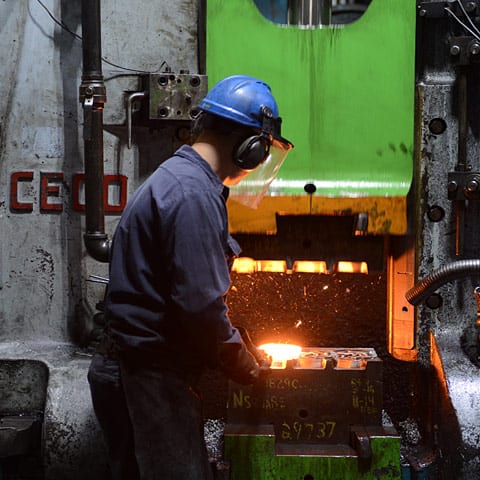Metal Forging
Traditional Skills; Today’s Technology
 Forging is one of the oldest known techniques of working with metal. For thousands of years, it was done by hand by a smith with a hammer, anvil and coal forge; temperature was gauged by the color of the metal.
Forging is one of the oldest known techniques of working with metal. For thousands of years, it was done by hand by a smith with a hammer, anvil and coal forge; temperature was gauged by the color of the metal.
We’ve become much more efficient since the days of the village smithy, with CNC-machined dies, rigidly-controlled hammers and presses and precision temperature control. Our capabilities include:
Drop Forging
Drop forging or hammer forging is exactly what it sounds like — just like the village blacksmith, but one capable of swinging a 5,000-pound hammer. We can perform both open- and closed-die forging on drop hammers ranging from 1,600 to 5,000 pounds.
Tooling for drop forging is generally less expensive than for press forging, but the quick hammer blows offer little control over flow patterns and pressure. It is best suited for smaller, less complex components of consistent thickness out of steel and steel alloys. Tighter tolerances are usually reached through secondary machining operations.
Press Forging
Instead of a millisecond-long hammer blow, a forging press uses a longer, more controlled mechanical or hydraulic force. Used primarily for closed-die forging, we have a 1,500-pound mechanical press and a 3,500-pound hydraulic press.
These are used for components that are more complex or require tighter tolerances. It offers more control over the blow pattern, and by manipulating the pressure to different parts of the die, operators can control and adjust the impression. Press-forged components also tend to have more uniform hardness. Aluminum forgings are usually produced by press rather than hammer.
Secondary Processes
Smith & Wesson Precision Components also offers a full range of secondary processes for forged components, such as coining, cold trim, stamping and forming, as well as variety of support services. They help ensure the highest standards of quality from start to finish.
Materials
We are equipped to forge metals including:
- Carbon steel
- Stainless steel
- Alloy steel
- Aluminum
- Scandium

